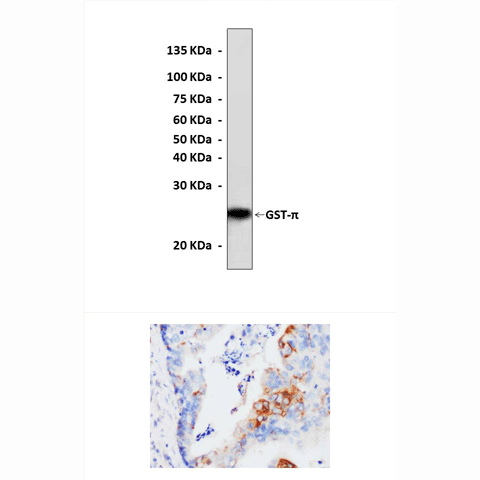Anti-GST-π: Rabbit Glutathione S-Transferase Pi Antibody |
 |
BACKGROUND Inhibition of free radicals and the damage they produce is critical for cell survival, particularly in neurons. Glutathione S-transferases (GSTs) are a class of inducible, multifunctional, detoxifying enzymes that catalyze the reduction of hydrophobic electrophiles, like those generated by pesticides and chemotherapeutic compounds. In mammals, six different isoforms alpha, mu, pi, theta, omega, and zeta have been identified.1 GST-Pi overexpression has been observed in many tumors compared with the surrounding normal tissues and in various cancer cell lines resistant to anticancer agents. It has been shown that GST-Pi acts as a regulator of mitogen-activated protein (MAP) kinases. GST-Pi is an endogenous inhibitor of c-Jun NH2-terminal kinase (JNK), mediated by interactions with the NH2-terminal region of the kinase. After oxidative stress, GST-Pi oligomerizes and disassociates from JNK, which then becomes phosphorylated. GST-Pi can also modulate the activation of p38 and extracellular signal-regulated kinase (ERK). For example, in NIH 3T3 cells, the forced expression of GST-Pi inhibits JNK activity and activates ERK and p38 kinase. In addition, in GST-Pi-deficient mouse embryo fibroblasts, the basal activities of JNK and ERK are higher than in their wild type counterparts.2
Epidemiology and experimental models indicate that several neurological disorders, including idiopathic Parkinson's disease (PD), arise from the combination of a genetic susceptibility and environmental exposure to compounds that generate oxidative stress. Brains of PD patients show numerous indicators of oxidative stress, including decreased levels of glutathione (GSH), increased lipid peroxidation, presence of dopamine quinones, DNA damage, and increases in JNK-mediated activation of c-Jun. GST-Pi is the only GST family member expressed in substantia nigra neurons. Differential expression of GST-Pi contributes to the sensitivity to xenobiotics in the substantia nigra and may influence the pathogenesis of reactive oxygen species-induced neurological disorders including PD.3
Epidemiology and experimental models indicate that several neurological disorders, including idiopathic Parkinson's disease (PD), arise from the combination of a genetic susceptibility and environmental exposure to compounds that generate oxidative stress. Brains of PD patients show numerous indicators of oxidative stress, including decreased levels of glutathione (GSH), increased lipid peroxidation, presence of dopamine quinones, DNA damage, and increases in JNK-mediated activation of c-Jun. GST-Pi is the only GST family member expressed in substantia nigra neurons. Differential expression of GST-Pi contributes to the sensitivity to xenobiotics in the substantia nigra and may influence the pathogenesis of reactive oxygen species-induced neurological disorders including PD.3
REFERENCES
1. Davis, W. Jr. et al: J. Pharmcol. Exp. Therapeut. 296:1–6, 2001
2. Gate, L. et al; J. Biol. Chem. 279:8608-16, 2004
3. Smeyne, M. et al: Proc. Natl. Acad. Sci. USA 104:1977-82, 2007
2. Gate, L. et al; J. Biol. Chem. 279:8608-16, 2004
3. Smeyne, M. et al: Proc. Natl. Acad. Sci. USA 104:1977-82, 2007
Products are for research use only. They are not intended for human, animal, or diagnostic applications.
Параметры
Cat.No.: | CA1040 |
Antigen: | Short peptide from human GST-Pi sequence. |
Isotype: | Rabbit IgG |
Species & predicted species cross- reactivity ( ): | Human, Rat |
Applications & Suggested starting dilutions:* | WB 1:1000 IP n/d IHC 1:50 - 1:200 ICC n/d FACS n/d |
Predicted Molecular Weight of protein: | 26 kDa |
Specificity/Sensitivity: | Detects endogenous levels of GST-Pi proteins without cross-reactivity with other related proteins. |
Storage: | Store at -20°C, 4°C for frequent use. Avoid repeated freeze-thaw cycles. |
*Optimal working dilutions must be determined by end user.
Документы
Информация представлена исключительно в ознакомительных целях и ни при каких условиях не является публичной офертой








